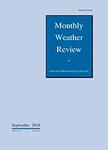版权所有:内蒙古大学图书馆 技术提供:维普资讯• 智图
内蒙古自治区呼和浩特市赛罕区大学西街235号 邮编: 010021

作者机构:Univ Colorado Boulder Dept Atmospher & Ocean Sci UCB 311 Boulder CO 80309 USA Univ Wyoming Dept Atmospher Sci Laramie WY 82071 USA
出 版 物:《MONTHLY WEATHER REVIEW》 (天气月评)
年 卷 期:2016年第144卷第9期
页 面:3277-3300页
核心收录:
学科分类:07[理学] 070601[理学-气象学] 0706[理学-大气科学]
基 金:AMS Graduate Fellowship Program Cooperative Institute for Research in Environmental Sciences (CIRES) NSF [AGS-1058426]
主 题:Geographic location/entity Complex terrain Circulation/ Dynamics Mesoscale processes Orographic effects Turbulence Wind shear Observational techniques and algorithms Radars/Radar observations
摘 要:Natural small-scale microphysical and dynamical mechanisms are identified in a winter orographic snowstorm over the Sierra Madre Range of Wyoming during an intensive observational period (TOP) from the AgI Seeding Cloud Impact Investigation (ASCII;January-March 2012). A suite of high-resolution radars, including a ground-based scanning X-band dual-polarization Doppler on Wheels radar, vertically pointing Ka-band Micro Rain Radar (MRR), and airborne W-band Wyoming Cloud Radar (WCR), and additional in situ and remote sensing instruments are used in the analysis. The analysis focuses on a deep postfrontal period on 16 January 2012 (I0P2) when clouds extended throughout the troposphere and cloud liquid water was absent following the passage of a baroclinic front. A turbulent shear layer was observed in this postfrontal environment that was created by a midlevel cross-barrier jet riding over a decoupled Arctic air mass that extended above mountaintop. MRR and WCR observations indicate additional regions of turbulence aloft that favor rapid particle growth at upper levels of the cloud. Plunging flow in the lee of the Sierra Madre was also observed during this case, which caused sublimation of snow up to 20 km downwind. The multi instrument analysis in this paper suggests that 1) shear-induced turbulent overturning cells do exist over cold continental mountain ranges like the Sierra Madre, 2) the presence of cross-barrier jets favors these turbulent shear zones, 3) this turbulence is a key mechanism in enhancing snow growth, and 4) snow growth enhanced by turbulence primarily occurs through deposition and aggregation in these cold (-15 degrees C) postfrontal continental environments.